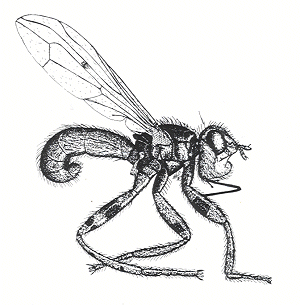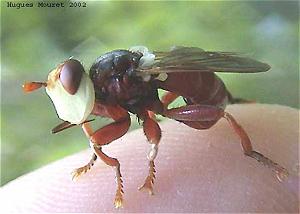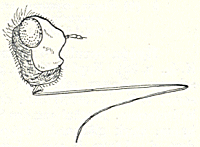
Introduction
Myopa are brownish to blackish Conopids,
which are immediately recognized by the large, inflated and whitish
face, which extends far below the eyes. They are found near all kinds
of flowering plants. M. tesselatipennis is often
taken from flowering scrubs like Craetegus, where
they sit on the twigs, on the hunt for hosts for their larvae. Others,
like M. buccata, are also found visiting flowers of
herbs, like Taraxacum. Their larvae are
endoparasites of bees, bumble bees and wasps (Vespula vulgaris).
2.b. Face: mouth edge white, without black stripes; tergite 4 and 5 either without dust or largely dusted, if dusted than the dustless spots at the front edge semicircular and not well separated -> 3
3.a. Scutellum black; abdomen blackish with brown edges, for M. fasciata with yellowish dust -> 4
3.b. Scutellum reddish; abdomen reddish
brown (like a broad Sicus). 11.5-15 mm. NL, B, D.
-> Myopa dorsalis Fabricius

Myopa dorsalis.
4.a. Wing: anal cell long; face under eyes bare -> 5
4.b. Wing: anal cell short, as in Dalmannia; face under eyes haired. 3.5-4 mm. D. -> Myopa morio Meigen
5.a. Femora orange to brown, with or without dark patches, along underside without or only with weak black bristles; antennae: segment 2 1.5 times as long as segment 3 (measured on the outside); more red-brown species, but thorax and abdomen can be largely black above; snout shorter or longer than head -> 6
6.b. Frons: black pattern in W-form, frons next to compound eyes dark; femur 1 brown without dark patch at the outside; antennae: arista uniformly pale; tergite 2 black, only brown at the very side margin; tergite 4-6 dusted over a small part of their surface, tergite 7 undusted; thoracic dorsum weakly dusted, without longitudinal stripes of dust. 5-8 mm (extrapolating the differences in thorax width of Stuke (2001) to body length) -> Myopa curtirostris Kröber
7.a. Cross vein at basis of cell R blackish -> 8
7.b. Cross vein at basis of cell R whitish; wing with a mix of white and black spots. 6-11 mm. NL, B, D. -> Myopa buccata Linnaeus
8.a. Wing: cell R without a black spot in the centre, but with black infuscations around some of its veins; snout shorter than M. picta -> 9
8.b. Wing: cell R with a black spot in
the centre; snout very long. 8-11 mm. B, D. -> Myopa
picta Panzer

Myopa picta, head (from Kröber)
9.a. Thoracic dorsum: black coloration extends all the way up to the base of the scutellum, at least medianly -> 10
10.a. Cross vein at basis of cell R is the only clear black marking in the wing, sometimes accompanied by weaker dark infuscations around the veins of cell R; wing: basal cells without white to yellow patches -> 11
11.a. Male: tergite 4 undusted or at most dusted medianly on the hind margin, not reaching front margin at the sides. Female: tergite 4 largely undusted, at most dusted in posterior half or less. Both: tergite 5: front margin undusted; wings often (but not necessarily) weakly infuscated along length veins. Abdomen dark orange to blood-red. 6-11 mm. NL, B, D. -> Myopa testacea Linnaeus
11.b. Males and females: tergite 4 dusted medianly from the posterior margin for at least half its length and dusting may reach front margin at the sides, tergite 5 medianly dusted for its whole length, often completely dusted; wings: hyaline of uniformly tinted not infuscated along length veins in addition to blackened base of cell R; Abdomen dark reddish brown. 4-6mm. Myopa stigma Meigen
12.a. Abdomen: tergite 5 with long hairs, which are at least as long as the largest diameter of tibia 3, the long hairs at tergite 5 perpendicular on or with an angle of 45 degree to the surface -> 13
13.b. Tibia 1 and 2: without a row of black appressed bristles (the only Myopa which lacks these hairs), longest hairs on these tibia much longer than the width of the tibia; tergite 5 with hairs at an angle of 90 degrees. 7-9 mm. NL, B, D. -> Myopa vicaria Walker
14.b. Palpae whitish (hardly contrasting with white mouth edge); snout 2nd and 3rd part equally long, each longer than tars 1. 8.5-10 mm. NL, B, D. -> Myopa pellucida Robineau-Desvoidy (=Myopa extricata Collin)
Van Veen M. 1984. De Blaaskopvliegen en roofvliegen van Nederland en België. Jeugdbondsuitgeverij, Utrecht.